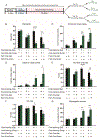Muscarinic antagonists impair multiple aspects of operant discrimination learning and performance
- PMID: 36529388
- PMCID: PMC9812939
- DOI: 10.1016/j.neulet.2022.137025
Muscarinic antagonists impair multiple aspects of operant discrimination learning and performance
Abstract
Acetylcholine signaling can strengthen associations between environmental cues and reward availability. Diverse subtypes (M1-M5) of the muscarinic acetylcholine receptor (mAChR) family may have distinct roles in different learning and memory processes, such as encoding cue-reward associations and consolidating these associations in long-term memory. Using an operant discrimination learning task in which mice are trained to nose poke during a tone to receive a food reward, we found that acquisition of the task requires mAChR signaling in the central nervous system. In addition, post-session injections of a broad mAChR antagonist, scopolamine impaired consolidation of the cue-reward memory. Further, after successful learning of a cue-reward contingency across multiple training sessions, mice that received a single pre-session injection of scopolamine were unable to use the learned cue association to receive rewards. Taken together, these data demonstrate distinct roles for muscarinic signaling in acquisition, consolidation and recall of the operant discrimination learning task. Understanding mechanisms underlying natural reward-related responding may provide insight into other maladaptive forms of reward learning such as addiction.
Keywords: Acquisition; Consolidation memory; Muscarinic receptor (subtype); Muscarinic receptors; Operant learning; Reward learning.
Copyright © 2022 Elsevier B.V. All rights reserved.
Conflict of interest statement
Declaration of Competing Interest The authors declare that they have no known competing financial interests or personal relationships that could have appeared to influence the work reported in this paper.
Figures



References
-
- Nisanov R, Galaj E, & Ranaldi R (2016). Treatment with a muscarinic acetylcholine receptor antagonist impairs the acquisition of conditioned reward learning in rats. Neuroscience Letters, 614, 95–98. - PubMed
-
- Galaj E, Nisanov R, & Ranaldi R (2017). Blockade of muscarinic acetylcholine receptors in the ventral tegmental area blocks the acquisition of reward-related learning. Behavioural brain research, 329, 20–25. - PubMed
-
- Crouse RB, Kim K, Batchelor HM, Girardi EM, Kamaletdinova R, Chan J, Rajebhosale P, Pittenger ST, Role LW, Talmage DA, Jing M, Li Y, Gao X, Mineur YS, & Picciotto MR (2020). Acetylcholine is released in the basolateral amygdala in response to predictors of reward and enhances the learning of cue-reward contingency. Elife, 9, e57335. - PMC - PubMed
Publication types
MeSH terms
Substances
Grants and funding
LinkOut - more resources
Full Text Sources

